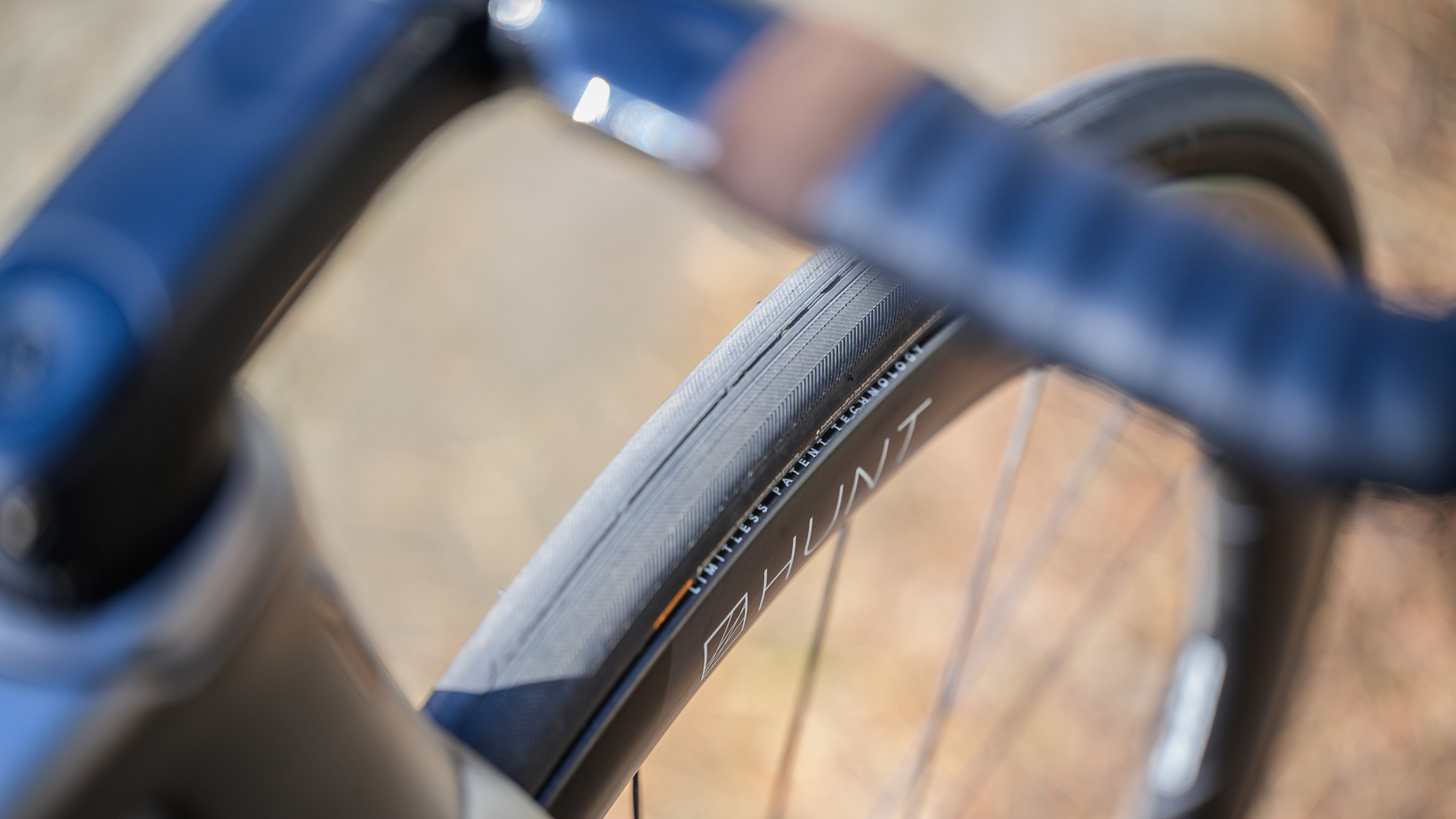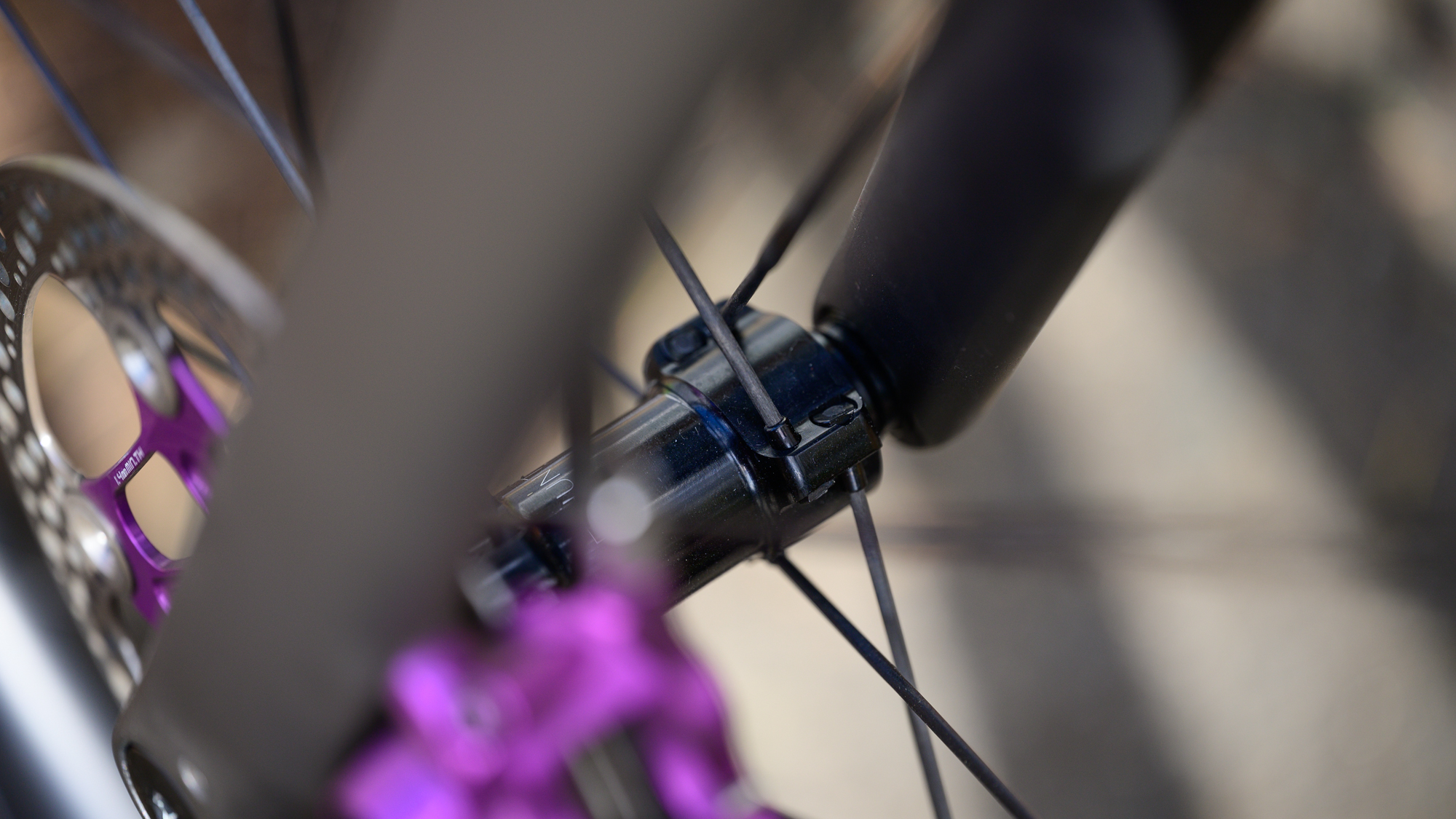
Price: £2,289 / $2,789 / €2,749
Rim Dimensions: Depth: 49.5mm F/R, Internal width: 23.0mm F/R, External Rim Width: 34.2mm F / 30mm Rear
Weight: 1383g as weighed with tape and valves
Hubs: HUNT H_Ratchet DBL dual-sided ratchet system with 40-tooth drive ring
Spokes: 18 front and 20 rear using TaperLock UD Carbon Spoke technology
As I write this in 2024, most modern bikes are now running disc brakes. Although Shimano technically still sells rim brake groupsets, they aren't exactly easy to find. For all practical purposes, the shift from rim to disc is long since complete and the benefits are obvious. That hasn't always been the case though and it wasn't long ago that people were still asking why make the switch?
Back in 2019, the landscape looked a lot different. The industry was shifting but it was far less clear why. That year Hunt brought Limitless tech to market. Limitless tech allowed for external wheel widths which weren't possible with rim brakes but also brought better aerodynamic performance. Simply said, Hunt led the industry by showing that disc brakes were about far more than braking performance.
The next frontier is only slightly less radical. With wheel designs free from the limitations of rim brake callipers, brands are showing that wider internal width designs paired with wider tyres are both faster and more comfortable. Many of the options you'll find in our list of the best road bike wheels are either already wide and hookless, or moving in that direction.
With the HUNT SUB50 Limitless Aero Disc, the brand is again demonstrating the why of a new technology. It's also yet another indication that Hunt is ready for consideration compared to older and bigger brands. If you are considering a new set of everyday go fast wheels for this summer, keep reading to see what Hunt has to offer.

Design and aesthetics
Whatever you might think about Hunt wheels, the brand is one of the leaders in the technology of aerodynamic bike wheels. Hunt isn't always the fastest but the brand is clear about that and clear about how fast the products are. When it comes to the SUB50 that means you can find all the details you want in relation to design and testing and that starts with Limitless technology.
Limitless technology isn't actually new to the SUB50. It's the technology that Hunt started working on in 2017, eventually coming to market in 2019, and it's all about keeping weight down on a wide wheel. What that means is that while we all think of carbon fibre as being exceptionally light, there are lighter materials. Carbon is exceptionally strong for the weight but when Hunt pushed out to a width of 34.5 mm at the widest point of the wheel, the brand recognized it needed a new material.

Hunt Limitless wheels still use carbon fibre for the structure of the wheel but filling the interior space with enough carbon for strength would be too heavy. Instead of carbon fibre Limitless wheels use a low density polymer (density of 0.7g/cm3 vs carbon fibre prepreg of 1.6g/cm3) to fill the space inside the wheel. The polymer is "co-cured to the carbon during the curing process, resulting in a strong and uniform bond" that offers similar strength to standard wheels at a lower weight.
The SUB50 design then takes the established Limitless technology and applies it to a new shape. The goal of the new shape is to both cater better to the trend towards wider tyres and also drive down the system weight. Accomplishing both of these goals meant Hunt started with "approximately 2500 hours of CFD (computational Fluid Dynamics) analysis" followed by wind tunnel tests of a number of 3D printed prototypes, and then final carbon fibre models of the chosen geometries.
The result of all this is a wheelset that brings the weight down to 1380 grams (my scale added 3 grams for the tape and valves) for the carbon spoke version of the SUB50. The new shape is slightly narrower at 34.2 mm across the widest point but also up a half mm to 23 mm on the inside. It's optimised for 28-30mm tyres, the hooks are now gone, the depth is 49.5 mm, and the rear wheel is a bit different in shape, bulging out to only 30mm at the widest point.
The team also tackled the hub design for the SUB50. While previous Hunt hubs had a design with pawls, the SUB50 switches to a DT Swiss style double ratchet, offering a 9-degree engagement. There's also a tool-free end cap design and double sealed main bearings.



Performance
Although I left the design and aesthetics section to the design alone, it's actually the aesthetics that I noticed first about the HUNT SUB50 Limitless Aero Disc. I've always been a fan of the Hunt aesthetics but the SUB50 really steps it up a notch. The paint on the outside is gone, replaced with only a clear coat over the raw carbon. Although the line graphics remain, they've now seen a transformation to much more subtle reflective colour. It's really the typography that I love though.
Hookless wheels offer claimed improvements in consistency of manufacturing, a better rim-to-tire interface for aerodynamics, but the real advantage to consumers is more tyre volume. More tyre volume means lower pressure and a more comfortable ride but it does also make it possible to experience a pinch flat situation that actually cuts through the tyre. This is something Enve addressed when the brand launched the updated SES line, including the Enve SES 4.5, and it's also something Hunt mentions. There's so much room on the edge of the rim-to-tire interface that Hunt can print graphics on it but Hunt does this because "a wider hookless bead profile also helps reduce the chance of pinch flats, due to the blunt, flattened profile."


In terms of actually using the wheels, the first thing I noticed was setting up the tyre. As I investigated the safety of hookless wheels and tires recently, Jan Heine explained to me some information about simple ways the two should interact. He explained that it was important that the rim valley retained the tire even if it somehow came off the shelf and it should take a good amount of pressure before the tyre seats. Using a Cadex Race Tyre (one of my favourites and a tyre I know well) I found it basically impossible to rotate the tyre and align the valve with the graphics (just take it off and put it back on). That's a good sign and so is the tire seating at over 50 psi. You can read more about how Hunt tests hookless retention but, from a consumer standpoint, everything I saw was positive. Finally, with a tyre on, it was time to head out and do some testing.
When you ride the Hunt SUB50, it's all about the weight. This is a light wheel. I am riding the carbon spokes and ceramic bearings and at 1380 grams, it's one of the lighter wheels I have available. For the most part, that lack of weight is what I feel with them. There's a lot more punch to the acceleration compared to the much heavier Hunt Limitless 60 wheels. If you like to punch above your FTP on short hills, it's rewarded. Long hills always feel like long hills but general shenanigans and wasting of energy with small sprints is fun on the Hunt SUB50.
At the same time one of the defining characteristics of the 60 is how stable it descends. I don't find the SUB50 to have that same sense of stability. It's not that they are unstable but I wouldn't call descending stability a defining characteristic. Hunt suggested that's probably to do with the drastic reduction in weight.
As I spent more time on the new Hunt wheels, I did start to get more used to the lightness and started to compare them. The second point you feel is that they are comfortable. The Cadex tires puff out and at 50 psi the combo is a joy over the long distances I prefer. It's not as comfortable as the Zipp 353 NSW but it's more comfortable, as well as slightly less punchy, than the Cadex 50 Ultra.
The Hunt wheels feel closest to either the Enve SES 4.5 or the Roval Rapide CLX II. All three use a split front/rear design and have similar depths. Enve wheels are a much more visceral ride experience partly because of the noise they make but the Roval and the Hunt wheels are very close. Hunt tests show that the Roval wheels are still just a bit faster in a straight line although the Hunt SUB50 is much lighter. Personally, I prefer the Hunt option as not only are they lighter but the wide hookless internal is more comfortable.
When I was able to settle in on long straight sections, I never felt like the Hunt wheels were grabby and they hold speed exactly as you'd expect from a wheel of this depth. I can labour the point but these are good everyday wheels that handle crosswinds well and are quick to accelerate. You won’t lose performance running a 28 or 30mm tyre and you get a lot of comfort from the added air volume.
In terms of the hub, it works. The old hub worked for me through a ridiculous number of wet wintery hours and without maintenance so I’m not looking for an upgrade in that respect. I also can’t feel any difference with the new one. If you are worried about the sound, it’s far less aggressive than Cadex or Chris King but certainly not whisper quiet. I did notice though that nothing went flying when I swapped freehubs. Losing pawls was a frequent issue in the old hub and the new design fixes not only that but also gets rid of the need for tools. I'm a fan for those reasons alone.




Verdict
Among all the tech details and aesthetics, the HUNT SUB50 Limitless Aero Disc is also a statement from Hunt. Whatever you might think of the brand, this is not a budget wheel. Option up the SUB50 and you will find yourself matching prices with Enve, Roval, and other choices in the meat of the everyday aero wheel category. These are premium wheels with technology to command a price point that matches. It's worth remembering though, Hunt is actually offering features that are one more level up. Carbon spokes and ceramic bearings generally cost more and you can either get them at this level or leave them out. Leave them out if that's your choice and you'll step down one price point but retain most of the performance.
In terms of that performance, the Hunt SUB50 is both light and aero enough that only a few years ago you might have found "have it all" in the headline. Today the weight isn't quite as exceptional unless you think about it in terms of how wide the wheel is. Hunt is ushering in a focus on wider tyres while also being among the fastest aerodynamically and keeping weight controlled. If your wheels aren't light and fast with a 28 mm, or even a 30 mm, tyre then Hunt just made them obsolete. There are technically faster wheels out there but they are heavier and the expectation is that you are going to ride with a 25 mm tyre. That's a concept that's fading fast and if you are buying wheels to last for a long time it doesn't make sense to choose an outdated design. If you want a light and comfortable aero wheel, that's the Hunt SUB50.







